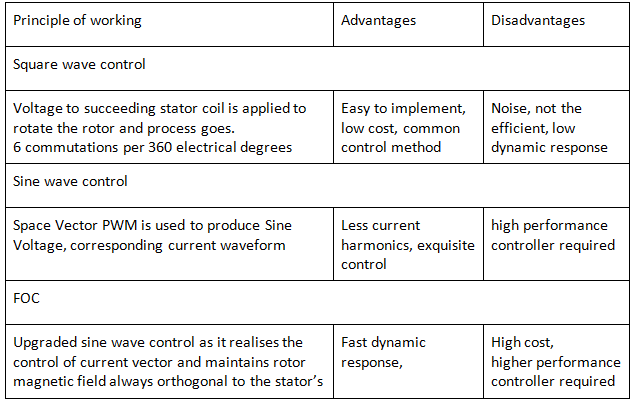Here, I am describing the working, assembling for EV applications, debugging. This is a pure guide to run Electric Vehicle on BLDC motor.
Let’s starts with the basics.
What is the BLDC motor?
Brushless DC motor is a substitute solution for the replacement and maintenance of worn-out carbon brushes in a DC motor due to arcing effects at the commutator.
How does BLDC Motor work?
The Stator’s architecture and design of the BLDC motor resemble the DC Motor expect for the part of the commutator and carbon brushes which essentially alternates the current direction in the coils of the armature.
BLDC rotor is equipped with the Permanent magnets, unlike the conventional in the DC machines’ rotor. And the control is achieved by turning the supply to the appropriate stator coils using an external converter.
The turning ON/OFF of the stator coil is guided through the hall sensor feedback, which is mounted on the motor, states the position of the rotor.
There are different types of controls like-
- Trapezoidal (square wave or 120 o or 6 step commutation control),
- Sinewave control (Space Vector control),
- FOC (or Vector Frequency control or magnetic field vector directional control)

How to Select a Motor and Battery for Your EV Vehicle?
Quick guide:
- A BLDC motor of at least 2000 RPM
- Two-wheeler (gearless bike): 1.5 kW (approximately) with the gear ratio 1:6 to 1:7, 1-1.75 kWh battery with the current discharge of at least 12A.
- Three-wheeler (rickshaw): 3-5 kW with the same gear ratio, 3-5 kWh battery with the current discharge of at least 16A.
These numbers are only for reference purposes. It is recommended to calculate the ratings of the BLDC motor and the gear ratio according to one’s own requirements.
Related Read: Difference between Electric Motor and Generator
How to Make the Connections?
For any outsourced (off the shelf) Motor and Motor Controller, you can see many wires that strangle out of the controller. Of which, it’s very important to find the wires which would be useful for us.
You need
- 2 battery input terminals
- 3 phase wires output to Motor
- 5 Hall sensor (3 hall sensors’ signal, Positive 5V, Ground)
- 3 throttle wires (Positive 5V, Ground, Signal)
- 2 electric lock (switch)
After the identification of the necessary wires, connect them appropriately (follow the color code).
Types of Electric Locks:
There are two kinds of electric locks,
- There is a direct open connector plug which is needed to be shorted
- A wire which will intake System Voltage from battery’s positive terminus
The throttle can be connected to a potentiometer or 49e series hall effect sensors accompanied by a magnet.
Give the throttle and the motor should run.
How to Debug if Connections are Proper?
You can use different Electrical Measuring Instruments (EMI) to check the connection.
- Make sure that the Electric lock is ON (shorted).
- Take a voltmeter and check at the battery terminals is having enough supply Voltage.
- Check the red wire in Hall sensor’s and the throttle is getting 5V supply with a multimeter.
- Check if any signal is coming from Signal wire (green) of the throttle given a rise in the throttle.
- Check hall sensors are color code matched, if yes, hook up a CRO or DSO for any of the Motor’s hall sensor signal and turn the motor manually to see pulses in the voltage.
This is the simple guide to run Electric Vehicle on BLDC motor. If you have any questions, write to me in the comment.
Read the related article:
How to check motor continuity